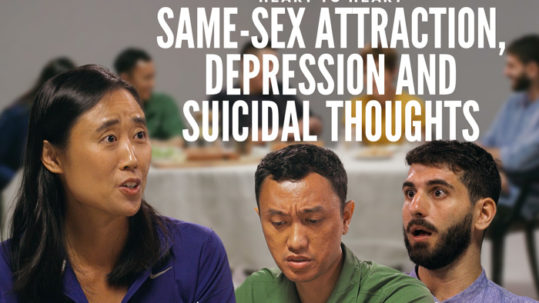21 Apr How to Talk to Your Preschoolers (0-6 yrs) About Homosexuality

Teach your children a simple, four-part story of our world: God made a good world; people did not obey God and sinned; God forgives, saves and transforms those who follow Jesus Christ; and He will gloriously remake us and this world.
When children take in and process new information, they start from what they already know, connecting new information to their previous knowledge.
When children take in and process new information, they start from what they already know, connecting new information to their previous knowledge. Before your children are even aware of homosexuality, begin by giving them a biblical view of the world.
In other words, you are framing the issue for them by teaching them about God and His redemptive plan for humankind. You are providing your children with a basic understanding of the world in which we live. We always want to start with what’s good when talking about difficult subjects, so we begin by teaching about God’s plan for us and our sexuality. That gives us a foundation for then discussing any problem issues.
Find a good children’s Bible or Bible storybook and read it with your child. As they grow and learn, this framework provides the starting place for discussing issues such as homosexuality.
Creation
- God made the earth and all that’s in it; He is the source of all life.
- God made people in His image and loves us very much. You are deeply loved by God.
- God separated humanity into male and female. Both boys and girls (and men and women) are good, but different.
- Children come from a mother and father; God intended parents to love, care for, protect, teach and guide children as they grow.
- God gives us good gifts, like friendship, marriage and family.
The Fall
- Adam and Eve disobeyed God and sinned. They did not trust God and did what God told them not to do. They ate from the tree of the knowledge of good and evil.
- This had bad consequences, as sin and death entered the world.
- People do wrong things, even moms and dads, and we all need God to forgive us and help us do what’s right.
- When we do something wrong, we admit it and ask other people to forgive us, too.
Redemption
- Thankfully, God set about bringing redemption to the earth from the very beginning, promising to Eve that a Savior would come.
- This thread of salvation and redemption is woven throughout the Old Testament, growing and expanding, as God makes promises to Noah, Abraham, Isaac, Jacob, Moses and all Israel.
- All those promises are fulfilled in Jesus Christ, whose message is that all may come into the life and redemption God has promised and become His followers.
- The good news is that Jesus’ life, death, burial and resurrection brings salvation and freedom from sin!
- When we choose to put our confidence in Jesus and follow Him, we are born into God’s family. God gives His children the Holy Spirit to help, guide and transform us in the middle of a fallen world.
- God helps us to treat all people with kindness, even those who sin against us, who are different from us or with whom we disagree.
Glorification
- Our future union with Christ is portrayed in Scripture as a wedding feast, where we are united with Christ like a bride and her husband.
- Those who follow Jesus will be with Him forever in a new heaven and earth.
- The Bible tells us that this will be a world with no pain, sin or sadness.
- We have a future and a sure hope, because God has made these promises to those who follow Him.
Use simple Bible stories, such as the Creation story, to show how God made Adam and Eve for each other and created the first marriage.
Use simple Bible stories, such as the Creation story, to show how God made Adam and Eve for each other and created the first marriage. Use the story of Noah to show the animals, two-by-two, male and female, going into the ark. A mommy animal and a daddy animal together have a baby animal.
Also use examples from life to teach these truths, explaining, for example, that Mom and Dad were married—marriage is a good gift from God. When a child sees something bad, you might explain how sin brought pain into the world. When your children start noticing that boys and girls are different, use that to talk about God separating humanity into male and female. Life is full of such teachable moments!
Real-Life Scenario
Your family is spending time together during the school holidays. As you enjoy the sights, you notice that a gay pride event is taking place nearby. Your family starts to see same-sex couples holding hands. Your young son or daughter asks, “Why are those two men holding hands? Why are those two women kissing?”
Possible Responses
These depend on the age of the child, his or her level of concern about this scenario and his or her verbal and abstract ability:
- “Because of God’s word, the Bible, we believe God made men and women, and He planned marriage to be between a husband and wife. But sin came into the world and causes all of us to do wrong things. One wrong thing some grownups do is try to change God’s plan for marriage so that two men or two women can marry.”
- “Not everyone believes and follows God’s plan for marriage, so sometimes two women will act like they are married. But they can’t really be a husband and wife, because they are both women. Sin has confused them, and they need God’s help to follow Him.”
- “God made marriage to be between a man and a woman. But not everyone obeys God and follows His plan. So sometimes two men will decide to marry. But we believe that marriage really is between a husband and wife.”
- “When men and women grow up, most of them get married. God made marriage to be between one man and one woman. But because we live in a world where people do wrong things, sometimes two men will get married. Jesus can help them.”
Word Of Caution
At this age, you aren’t talking to your children about specific sexual activity; they’re not equipped to handle adult sexuality. Furthermore, we suggest waiting until kids are older before introducing terms such as “homosexuality,” “heterosexuality,” “gay,” “straight,” “LGBT” or any of its variants.
In addition, we also suggest not saying something like, “Those men are gay. Gay is when two guys like each other.” That’s confusing to boys, who at this age are developing a stronger internal sense of masculinity—primarily through distancing themselves from girls and identifying with and relating to other boys and men.
It’s very healthy and normal for a boy to have older boys and men who function as heroes or role models. Explaining homosexuality as “two guys who like each other” could prompt a young boy to doubt himself or his own feelings. He might think to himself, “I’m a boy and I like boys. Does that mean I’m gay?” Some children have come home from school lessons on homosexuality and asked this very question.
The same would absolutely apply to girls. We suggest you avoid such statements as, “Being homosexual or lesbian is when two girls like each other.” This takes what is a normal, healthy developmental stage—girls liking and connecting with each other or following older girls as role models—and equates it with homosexuality.







